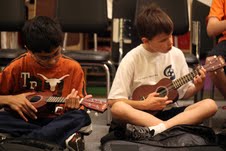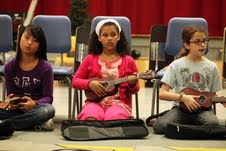Educator Conversations: Ukulele Orchestra of Great Britain
Editor’s note: This post is a part of a series of conversations between educators in the K-12 community. Educators will offer suggestions and answer questions about integrating UMS School Day Performances or the arts into classroom curriculum, as well as share advice on organizing a field trip to UMS. To volunteer to be a Teacher Lobby Moderator e-mail umsyouth@umich.edu. See other Educator Conversations here.
This week, our moderator answers frequently asked questions about teaching ukulele:
- Why ukulele?
- How did you purchase a class set of ukuleles?
- What kind of strings do you use?
- Do you let students take instruments home?
- What do you learn?
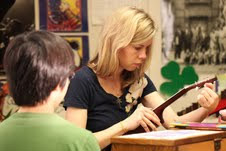 This week’s moderator: Katie Ryan. Katie is a proud graduate of the University of Michigan and Loyola University of New Orleans. Katie began teaching music in the Ann Arbor Public Schools in 1997 and her musical upbringing included experiences in piano, choir, madrigals, concert band, jazz band, musical theater, rehearsal and concert accompanying. She loves bringing a variety of musical experiences to her students at Angell Elementary School in Ann Arbor, Michigan, and hopes that their musical development will help them become life long enthusiasts of music.
This week’s moderator: Katie Ryan. Katie is a proud graduate of the University of Michigan and Loyola University of New Orleans. Katie began teaching music in the Ann Arbor Public Schools in 1997 and her musical upbringing included experiences in piano, choir, madrigals, concert band, jazz band, musical theater, rehearsal and concert accompanying. She loves bringing a variety of musical experiences to her students at Angell Elementary School in Ann Arbor, Michigan, and hopes that their musical development will help them become life long enthusiasts of music.
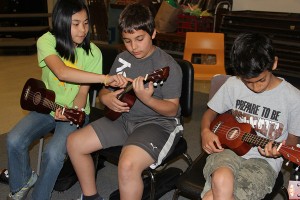
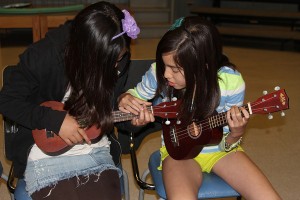
Photos: Students play ukueleles in Katie’s class.
Q: Why ukulele?
A: I’ve always enjoyed teaching recorder to students in third and fourth grades at my school. Because I work with many multi-age classes, I teach this unit every other year so I do not repeat units for students. For many children, the application of musical skills to instrument playing is extremely enjoyable. It’s satisfying for all to see everything come together in this process. In 2011, the Scientific American magazine published a series of articles about the exciting new research linking brain development in young people to experience playing instruments. Not all connections are understood at this point in time, but clearly this experience is powerful for young minds, even in ways that are not immediately evident.
I considered how wonderful it would be for students to have experience playing instruments over three years of their elementary school career, two years with me in vocal/general music and one year in our fifth grade instrumental music program. I reflected back to my own experiences playing ukulele in elementary school. I did research and found this is a common experience for students in Canada and the United Kingdom. I loved the idea that the soprano ukulele is the perfect size for students and that students can sing while playing it. The instrument is capable of playing melodies or chords, which is exciting. Teaching ukulele would lend a better opportunity to teach chord structure, harmonic progressions and form. I also considered that not all of my students will play in band/orchestra or sing in choir when they leave my school, but perhaps they might find some pleasure in playing the ukulele and this is may become a musical outlet for them as they go about their lives after elementary school.
Q: How did you purchase a class set of ukuleles?
A: I visited many of the local music stores in here in Ann Arbor, Michigan. I asked a lot of questions about sound quality and durability. I wanted something that would be a high quality instrument, produce a lovely sound and would hold up to multiple players. Because I planned to buy 25 + instruments, the music store offered a bulk discount, which helped bring down the cost significantly. I spoke with the store about thanking them in our school newsletters and my plans to direct families to them if students chose to purchase an instrument of their own. I believe our community patronized their business quite a bit, especially around the holidays.
After researching how much money I would need, I began looking for grants. Luckily, I live in a community where we have organizations such as the Ann Arbor Educational Foundation. It is an extremely generous organization. I wrote a grant for the instruments as well as soft-sided cases in which to store the instruments to protect the investment. The grant was approved and I was able to purchase most of the instruments. Our school PTO sponsored the purchase of the remaining instruments. I am extremely fortunate.
If you don’t live in a community that has an organization such as these, I’ve had many colleagues and friends recommend organizations such as Donor’s Choose and Adopt a Classroom. See these websites for more information:
http://www.adoptaclassroom.org/
Q: What kind of strings do you use?
A: The folks at my local music store recommended Aquila synthetic strings. They produce a warm tone and are easy to play. They have held up well to use by multiple players. The strings are color coded to make changing strings less challenging.
Q: Do you let students take instruments home?
A: No. Because I have multiple classes using the instruments, I’ve decided instruments must remain at school. I have opened my room up to students who wish to play more often during lunch times. I also structure the classes so that all students have an opportunity to practice/play/discover while I am working with individual students on tuning.
Q: What do you learn?
A: The unit was very successful. “Ukulele fever” was rampant across the school and I am definitely excited to teach the unit again next year. Currently, I will hold a ukulele lunch club for those who would like to continue playing this year. I learned a lot in the process:
I learned students would need to build up calluses, so I incorporated lots of breaks and “air ukulele” playing into our routines as students built up resilience in their finger tips.
Unlike recorders, ukuleles need to be tuned! I learned taking some time to help students with tuning at the beginning of class periods gives others an opportunity to practice. Usually, I would tune the instruments for the first group of students using the instruments in any given day. Classes following would be tuned on a “as needed” basis. Although I had to move quickly, this brief one on one interaction with students was a good relationship builder and something we don’t get to experience often enough when we see hundreds of students per day. Discussion often centered on if strings sounded too high or too low and the new G7 chord, but sports teams, pets, loose teeth and weekend plans were discussed as well, however briefly. I’ve found students are willing to work hard when they know you care about them.
I learned many songs can be sung/played with only two or three chords. There are lots of lists of songs and chords used for ukulele playing floating on the internet. My students became fairly fluent at playing chords used in C Major: C M, F M, G7 and a minor.
I learned how good it is to talk with students about the challenge of doing something new that does not come easily at first. Switching from one chord to the next requires an incredible amount of anticipation, planning, coordination and determination. Many students may feel frustrated at first. I find it’s important to acknowledge this and that learning in general can be hard work. As students find success, it’s all the sweeter.
Please feel free to contact me if you have any further questions! Happy strumming!
Do you have questions or comments for Katie or about teaching through ukuleles? Share your responses or questions in the comments section below.



